热处理工艺对30MnSi合金钢的影响(英文)
热处理对30CrMnSiNi2A钢组织与动态性能的影响
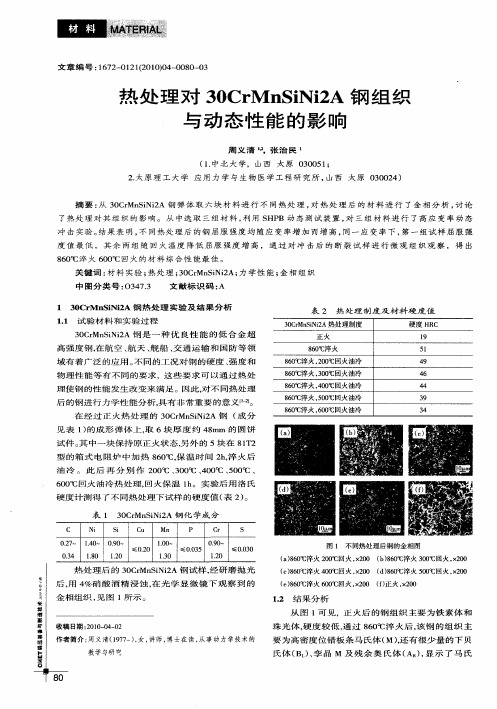
关 键 词 : 料 实验 ; 处 理 ; 0 r SNiA; 学 性 能 ; 相 组 织 材 热 3 C Mn i 2 力 金
中 图 分 类 号 : 4 . O3 73 文献标 识码 : A
1 3 Cr n i 2 钢 热 处 理 实 验 及 结 果 分 析 0 M S NiA
域 有 着 广 泛 的 应 用 。 同 的 工 况 对 钢 的 硬 度 、 度 和 不 强 物 理 性 能 等 有 不 同 的 要 求 ,这 些 要 求 可 以 通 过 热 处
理 使 钢 的 性 能 发 生 改 变 来 满 足 。因 此 , 不 同 热 处 理 对 后 的钢 进 行 力 学 性 能 分 析 , 有 非 常 重 要 的 意 义 【 。 具
■■
钢 试样 , 研 磨抛 光 经
显 微 镜 下 观 察 到 的
在读 , 从事动力学技术 的
体 束 , 束 由 大 量 近 乎 平 行 板 条 组 成 。 条 内具 有 很 每 板
高 的位错 密度 , 缠结 的方 式结 成位 错胞 。 钢部 分 以 该
下 贝 氏体 在 淬 火 时 先 于 马 氏 体 形 成 ,它 不 同 程 度 的 分 割 了原 A 晶 粒 ,从 而 细 化 了 马 氏 体 。所 以 , 经
文 章 编 号 : 6 2 0 2 (0 00 — 0 0 0 1 7 — 1 12 1 ) 4 0 8 — 3
Hale Waihona Puke 热 处 理 对 3 Cr n i 2 钢 组 织 0 M SNiA 与 动 态 性 能 的 影 响
周 义 清 张 治 民
(. 1 中北 大 学, 山西 太 原 0 0 51 30 ; 2太 原 理 工 大 学 应 用 力 学 与 生 物 医 学 工 程 研 究所 , 西 太 原 0 0 2 . 山 3 0 4)
金属的热处理 毕业论文外文文献翻译
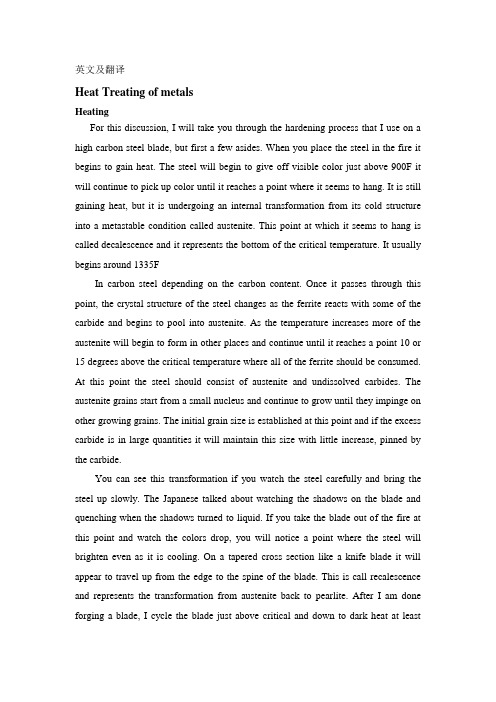
英文及翻译Heat Treating of metalsHeatingFor this discussion, I will take you through the hardening process that I use on a high carbon steel blade, but first a few asides. When you place the steel in the fire it begins to gain heat. The steel will begin to give off visible color just above 900F it will continue to pick up color until it reaches a point where it seems to hang. It is still gaining heat, but it is undergoing an internal transformation from its cold structure into a metastable condition called austenite. This point at which it seems to hang is called decalescence and it represents the bottom of the critical temperature. It usually begins around 1335FIn carbon steel depending on the carbon content. Once it passes through this point, the crystal structure of the steel changes as the ferrite reacts with some of the carbide and begins to pool into austenite. As the temperature increases more of the austenite will begin to form in other places and continue until it reaches a point 10 or 15 degrees above the critical temperature where all of the ferrite should be consumed. At this point the steel should consist of austenite and undissolved carbides. The austenite grains start from a small nucleus and continue to grow until they impinge on other growing grains. The initial grain size is established at this point and if the excess carbide is in large quantities it will maintain this size with little increase, pinned by the carbide.You can see this transformation if you watch the steel carefully and bring the steel up slowly. The Japanese talked about watching the shadows on the blade and quenching when the shadows turned to liquid. If you take the blade out of the fire at this point and watch the colors drop, you will notice a point where the steel will brighten even as it is cooling. On a tapered cross section like a knife blade it will appear to travel up from the edge to the spine of the blade. This is call recalescence and represents the transformation from austenite back to pearlite. After I am done forging a blade, I cycle the blade just above critical and down to dark heat at leastthree times. I watch for these two points to establish critical in my mind and to set up a very fine grain pearlite structure in the steel.After reaching critical temperature, the steel should be fully austenized, but the carbides will continue to dissolve. It may be necessary to soak at temperature to fully dissolve all the carbides. In some steels it may be necessary to continue to raise the temperature for this to be accomplished especially in the presence of alloying elements that retard the transformation.Once the steel is above critical and austenite, it may be quenched and hardened. The structure of the steel can be established by carefully controlling the time it takes the steel drop from critical through the various temperature sensitive points.Transformations on CoolingAnnealing, normalizing, quenchingThe structure and hardness of the steel is established by the rate of cooling from the austenitic condition. If brought down slowly the steel will be annealed and soft. The structure will be mostly ferrite and cementite, carbides. This can be done in a temperature controlled furnace by dropping the temperature through a known rate over a set period of time dependent on the type of steel. Another method is to preheat a heavy bar of low carbon to the same temperature as critical for the steel and bury both of them together in vermiculite. It will slow the cooling rate down so that the blade will still be hot to the touch the next day. For most of the carbon steels this will be enough to anneal the piece.If allowed to air cool it will be normalized, a tougher condition comprised of fine pearlite and carbides. Blades can be prepared for heat treatment in either normalized or annealed states. Another treatment that is particularly effective for workability and for dimensional stability is called sphereodizing. With the steel in a normalized condition you reheat, usually in salt to inhibit oxidization, to a temperature just below lower critical, 1300F and hold for at least an hour. What occurs is that the carbideswill begin to aglomulate or pool into larger more evenly spaced particles in a ferrite matrix. It makes handfinishing much easier.It is important to precondition your blades not only because it helps workability, but also to stress relieve the steel after forging. This will reduce chances of cracking and warping in the quench. It is helpful to think of the forging stage as the beginning of the heat treatment and to pay careful attention to the heats especially in the final forging. My last heats are always at critical. When the blade is finally shaped, I cycle the blade just above critical and down to almost black heat at least three times, cooling between by moving it back and forth in the air gently.HardeningYou have a lot of options when it comes to hardening carbon steel. Even the slightest change in alloy content can make a remarkable difference in the hardening characteristics of the steel, so I would again encourage you to study the steels you will be using.The transformation temperatures and times are described using a chart that shows the Ae1 line, the temperature at which austenite begins to form and the Ms line, the temperature at which martensite starts to form from austenite.The time line at the bottom of the chart is in seconds and side bars give temperature. This is called an "S" curve chart and it is very useful in determining the quench speeds for each steel. The top curve of the "S" is known as the nose of the curve. When quenching from critical, the temperature of the steel must drop below the nose of the curve within a precise amount of time in order for the steel to harden to martensite. In this case, it must get below 900F in under five seconds to form martensite.MarquenchingIf the steel is quenched to below the Ms, martensite will be the predominate structure, however if the blade is quenched to a point slightly above the Ms point, say around 500F and held until it has stabilized at that temperature, the steel has thepromise to form martensite, but will not set up until it drops below Ms. This is called marquenching and is commonly used because it is less stressful particularly in difficult cross sections like we encounter in knife blades. When the blade is removed from the quench it is still above the Ms point and has very unusual properties. It can be easily bent or straightened and is still quite soft. As it cools however, it begins to setup martensite and will harden at room temperature. Again, you need to look at the chart for each steel you will be using because the Mf, or martensite finish point can be well below room temperature on some highly alloyed steels. These steels benefit from sub zero quenching because the colder temperatures are necessary to complete the austenite transformation and to reach the martensite finish. Care must be taken that the blade is not chilled by placing on a cold surface or even by being placed in a breeze or draft. The safest method is to allow it to cool in still air. The blade should be tempered after it has cooled to the point where it can be handled with bare hands.AustemperingIf the steel is quenched from Ae3, critical, to a point between the Ms and the nose of the curve, say 600F and held at temperature for a long time, the austenite will convert to banite. Banite is a much tougher structure than martensite and will maintain the hardness of the steel as tempered to that temperature. This process requires a salt bath and good controls, but makes an really tough spring and is being used by some makers on steels like 52100.QuenchantsThe method of controlling the speed of cooling is the quenchant. The quench rate is determined by how quickly the quenchant can remove the heat from the steel. When a piece of hot steel enters the quenchant the area surrounding the blade absorbs heat from the blade until it is heated itself.金属的热处理加热加热这种讨论,我将以高碳钢为例向你介绍其硬化过程.首先,你把钢铁放在火上加热时。
热处理工艺守则及热处理工艺对30CrMnSiA组织与性能的影响
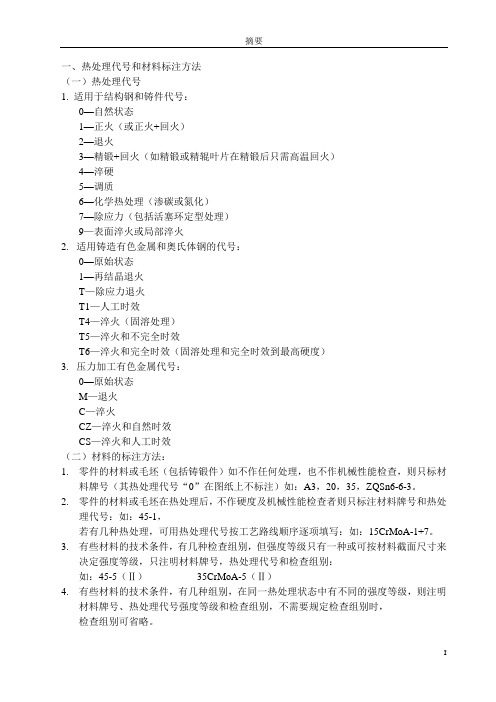
一、热处理代号和材料标注方法(一)热处理代号1. 适用于结构钢和铸件代号:0—自然状态1—正火(或正火+回火)2—退火3—精锻+回火(如精锻或精辊叶片在精锻后只需高温回火)4—淬硬5—调质6—化学热处理(渗碳或氮化)7—除应力(包括活塞环定型处理)9—表面淬火或局部淬火2.适用铸造有色金属和奥氏体钢的代号:0—原始状态1—再结晶退火T—除应力退火T1—人工时效T4—淬火(固溶处理)T5—淬火和不完全时效T6—淬火和完全时效(固溶处理和完全时效到最高硬度)3.压力加工有色金属代号:0—原始状态M—退火C—淬火CZ—淬火和自然时效CS—淬火和人工时效(二)材料的标注方法:1.零件的材料或毛坯(包括铸锻件)如不作任何处理,也不作机械性能检查,则只标材料牌号(其热处理代号“0”在图纸上不标注)如:A3,20,35,ZQSn6-6-3。
2.零件的材料或毛坯在热处理后,不作硬度及机械性能检查者则只标注材料牌号和热处理代号:如:45-1,若有几种热处理,可用热处理代号按工艺路线顺序逐项填写:如:15CrMoA-1+7。
3.有些材料的技术条件,有几种检查组别,但强度等级只有一种或可按材料截面尺寸来决定强度等级,只注明材料牌号,热处理代号和检查组别:如:45-5(Ⅱ)35CrMoA-5(Ⅱ)4.有些材料的技术条件,有几种组别,在同一热处理状态中有不同的强度等级,则注明材料牌号、热处理代号强度等级和检查组别,不需要规定检查组别时,检查组别可省略。
25Cr2MoV A-5 25Cr2MoV A-5如:735-Ⅲ7355. 有些零件或者是比较重要或者是技术要求比较复杂,用上述标注方法不能说明全部要求者,则应注明标准号,在同一热处理状态中有不同的强度级别时,还应注明强度级别。
35CrMoA-5 35CrMoA-5如:Q/CCF M 3003-2003 590×Q/CCF M 3003-20036. 大锻件如叶轮、铸造轴、整体转子等的材料标注方法钢号锻件级别×标准编号7. 铸钢件:铸铁、铜件:材料牌号类别材料牌号标准号标准号8.铸铁件及有色金属等直接按上述方法标注可能引起误解时,热处理代号加上括号。
热处理工艺参数对30CrMnSiNi2A钢组织及性能的影响

热处理工艺参数对30CrMnSiNi2A钢组织及性能的影响摘要:为研究热处理工艺参数对30CrMnSiNi2A钢组织及性能的影响,对奥氏体化后经不同等温温度、不同回火温度下的30CrMnSiNi2A钢试样进行力学性能检测和金相组织分析。
研究结果表明,30CrMnSiNi2A钢奥氏体化后在200~600℃回火,随着回火温度的升高,强度和硬度下降、延伸率和断面收缩率整体呈缓慢上升趋势,其金相组织由回火马氏体逐渐向回火索氏体过渡;30CrMnSiNi2A钢经奥氏体化后在200~290℃等温淬火,随着等温淬火温度的升高,其金相组织由回火马氏体+无碳化物贝氏体逐渐转变为无碳化物贝氏体,抗拉强度和硬度显著下降,延伸率和断面收缩率变化不大。
关键词:超高强度钢,力学性能,回火马氏体,无碳化物贝氏体1 前言30CrMnSiNi2A是一种常见的低合金超高强度钢,热处理后可获得高的强度和较好的塑、韧性,广泛应用于我国航空工业[1]。
30CrMnSiNi2A钢常用的热处理工艺为淬火+回火或等温淬火+回火[2],热处理工艺的不同,其性能会出现较大的差异[3-5]。
本文主要通过对30CrMnSiNi2A钢进行加热和不同温度的等温淬火和回火处理,研究了不同等温淬火温度和回火温度对30CrMnSiNi2A钢热处理后组织和性能的影响,分析热处理后性能随温度变化规律和原因,为热处理工艺优化和不合格品处理提供依据。
2 试验材料及方法2.1试验材料试验用30CrMnSiNi2A材料试样均从某钢厂生产的Φ45mm热轧退火态钢棒上截取,其化学成分如表1所示。
表1化学成分元素C CrMnSiNiS P含量,%.311.111.081.121.65.005.0072.2试验方法试验材料按表2规格加工后按表3所列工艺进行热处理,1~6组试样奥氏体化保温后采用油冷淬火工艺,7~10组试样奥氏体化保温后采用等温淬火工艺,奥氏体化加热(含油淬和等温淬火)设备为多用途炉,回火设备为空气井式回火炉。
化学成分及热处理条件对30crmnsini2a钢机械性能的影响

东北大学硕士学位论文第2章30CrMnSiNi2A钢的试刮工艺研究经真空感应加真空I目耗重熔冶炼的30CrMnSiNi2A钢材,宏观低倍组织均匀致密,偏析程度较轻。
图2.230CrMnSiNi2A钢的低倍组织Fig.2.2ThemacrosU'uctureof30CrMnSiNi2Asteel2.3.3非金属夹杂物钢中非金属夹杂物的存在破坏了基体的连续性,钢的有效面积减少,承受变形功也相应减少,尖角部位在负荷作用下造成体积应力状态,韧性降低,聚集的夹杂物使晶格滑移困难,使钢的塑性下降,塑性夹杂物的存在随着锻轧过程延展变形,致使钢材产生各项异性。
对钢的机械性能在较大的影响,如导致应力集中,引起疲劳断裂。
当夹杂物较多时,塑性、韧性、强度、延展性、焊接性及耐蚀性都大大降低。
因此必须有效控制钢中夹杂物含量。
钢材的非金属夹杂物检验结果见表2.3,表中数据为多组数据的平均值。
钢材的非金属夹杂物(较严重视声场)见图2.3。
表2.330CrMnSiNi2A钢非金属夹杂物检验结果Table2.3Theanalysisresultsofnon—metallicinclusionsin30CrMnSiNi2Asteel东北大学硕士学位论文第2章30CrMnSiNi2A钢的试翻工艺研究电炉加炉外精炼冶炼精钢材杂质元素含量低,真空感应炉和真空自耗炉重熔具有较强的真空脱气、去除夹杂作用,因此30CrMnSiNi2A钢杂质元素含量低,钢质纯净,非金属夹杂物水平远远高于标准要求。
图2.230CrlVInSiNi2A钢的非金属夹杂物照片Fig.2.2Thelion-metallicinclusionsphotoof30CrMnSiNi2Asteel2.3.4机械性能机械性能是材料在一定的外界环境中在力的作用下所表现的性能。
材料的机械性能是其本身固有的特性,但在不同的外界条件下会有不同的表现,机械性能检验任务,在于正确评定材料承受各种外界损害的能力。
等温退火对30Si2MnCrMoVE钢显微组织和力学性能的影响
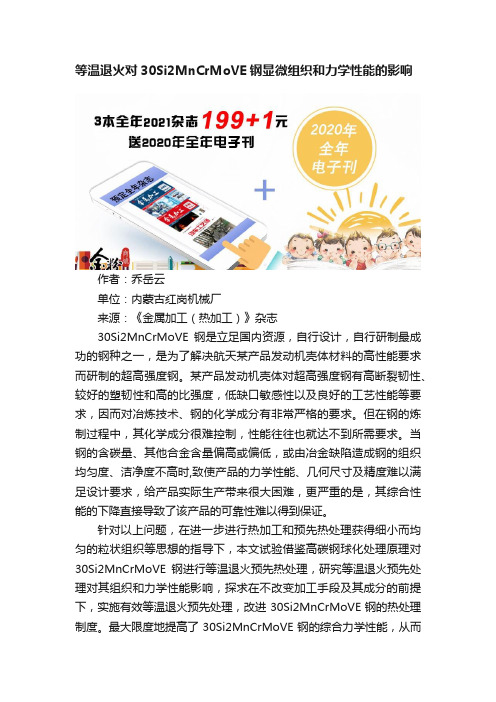
等温退火对30Si2MnCrMoVE钢显微组织和力学性能的影响作者:乔岳云单位:内蒙古红岗机械厂来源:《金属加工(热加工)》杂志30Si2MnCrMoVE钢是立足国内资源,自行设计,自行研制最成功的钢种之一,是为了解决航天某产品发动机壳体材料的高性能要求而研制的超高强度钢。
某产品发动机壳体对超高强度钢有高断裂韧性、较好的塑韧性和高的比强度,低缺口敏感性以及良好的工艺性能等要求,因而对冶炼技术、钢的化学成分有非常严格的要求。
但在钢的炼制过程中,其化学成分很难控制,性能往往也就达不到所需要求。
当钢的含碳量、其他合金含量偏高或偏低,或由冶金缺陷造成钢的组织均匀度、洁净度不高时,致使产品的力学性能、几何尺寸及精度难以满足设计要求,给产品实际生产带来很大困难,更严重的是,其综合性能的下降直接导致了该产品的可靠性难以得到保证。
针对以上问题,在进一步进行热加工和预先热处理获得细小而均匀的粒状组织等思想的指导下,本文试验借鉴高碳钢球化处理原理对30Si2MnCrMoVE钢进行等温退火预先热处理,研究等温退火预先处理对其组织和力学性能影响,探求在不改变加工手段及其成分的前提下,实施有效等温退火预先处理,改进30Si2MnCrMoVE钢的热处理制度。
最大限度地提高了30Si2MnCrMoVE钢的综合力学性能,从而满足了产品的技术要求,保证了产品使用的可靠性。
1.试验材料及方法(1)试验材料试验材料是国内某钢厂生产的φ180mm双真空冶炼钢棒料,该材料经我单位复验后得到的化学成分和力学性能均列于表1。
表1 材料的化学成分和力学性能C Si Mn Cr Mo V S P K1C/MPa·m1/2技术要求0.27~0.321.40~1.700.70~1.001.00~1.300.40~0.550.08~0.15≤0.010≤0.0150≥80现用材料0.30 1.50 0.92 1.18 0.44 0.13 0.090 0.013 54.4 58.3(2)试验方法将φ180mm的棒料经锻造后进行等温退火→粗加工→等温淬火→回火→精加工→标准拉伸、断裂韧度试样→性能测试,试样按国标GB/T228选取。
热处理工艺对30CrNiWVA钢的组织和力学性能的影响
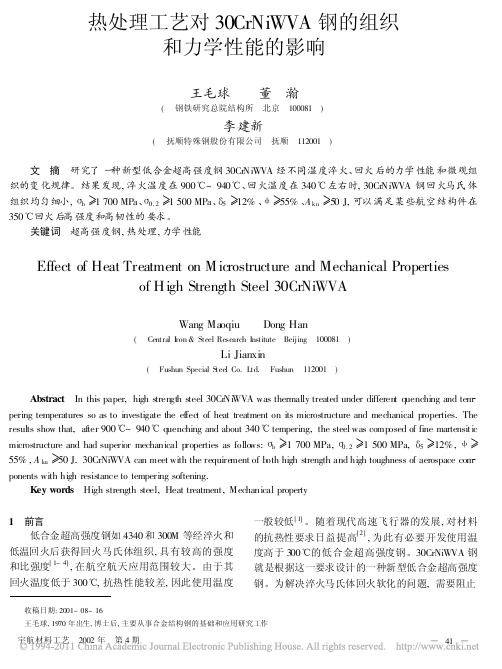
热处理工艺对30CrNiWVA钢的组织和力学性能的影响王毛球 董 瀚( 钢铁研究总院结构所 北京 100081 )李建新( 抚顺特殊钢股份有限公司 抚顺 112001 )文 摘 研究了一种新型低合金超高强度钢30Cr NiW VA经不同温度淬火、回火后的力学性能和微观组织的变化规律。
结果发现,淬火温度在900 ~940 、回火温度在340 左右时,30Cr NiW VA钢回火马氏体组织均匀细小, b1700MPa、 0.21500MPa、 512%、55%、A ku50J,可以满足某些航空结构件在350 回火后高强度和高韧性的要求。
关键词 超高强度钢,热处理,力学性能Effect of Heat Treatment on Mic rostructure and Mechanical Propertiesof High Strength Steel30CrNiWVAWang Maoqiu Dong Han( Central Iron&Steel Research Institute Beijing 100081 )Li Jianxin( Fushun Special S teel Co.Ltd. Fushun 112001 )Abstract In this paper,high strength steel30Cr Ni W VA was thermally treated under different quenching and tem pering temperatures so as to investigate the effec t of heat treatment on its microstructure and mechanical properties.The results show that,after900 ~940 quenching and about340 tempering,the steel was composed of fine martensitic microstructure and had superior mechanical properties as follo ws: b1700MPa, 0.21500MPa, 512%, 55%,A ku50J.30CrNiW VA can meet with the require ment of both high strength and high toughness of aerospace com ponents with high resistance to tempering softening.Key words High strength steel,Heat treatment,Mechanical property1 前言低合金超高强度钢如4340和300M等经淬火和低温回火后获得回火马氏体组织,具有较高的强度和比强度[1~4],在航空航天应用范围较大。
热处理工艺对30CrMnSi钢拉伸性能的影响

[1] 宫藤久元,细川弓,津野理一. リードフレーム用强化铜合 金 KFC-SHおよびKLF-SHTの特性[J]. 伸铜技術研究会誌, 1990,(29):225-232.
different heat treatment
呈现连续屈服变形,随回火温度的降低,抗拉强度
增大,并且在每一条曲线的后期,都表现出应变增
加而应力下降的现象,说明 30CrMnSi 钢在拉伸
时出现缩颈现象。由此可见,30CrMnSi 钢经常规 淬火 + 低回、中回、高回,均表现出一定的塑性。
从图 1 还可以看出,高温回火试样的塑性要 高于中温回火,由于高温回火时得到回火索氏体 组织,从而使其具有良好的塑性,但低温回火试样 的应变量最大,产生这一现象的原因是工艺控制 得当,使得晶粒细小所致。 2. 3 分析及讨论
2 实验结果分析及讨论
2. 1 30Cr MnSi 钢热处理后的硬度
对经不同工艺热处理后的 30CrMnSi 钢试样
进行洛氏硬度测试,结果如表 1 所示。可见超高温
淬火后的试样硬度最大,高温回火的硬度最低。常
表 1 不同热处理工艺的硬度值 Tab. l The har dness value of 30Cr MnSi Steel
摘 要:利用万能电子试验机对热处理后的 30CrMnSi 钢进行常温拉伸试验,分析热处理对其常温拉伸性能
的影响;利用洛氏硬度实验机对不同热处理后的 30CrMnSi 钢进行硬度测试,找出硬度的变化规律;同时利用扫描
电镜对拉伸断口进行形貌分析。结果表明:常规淬火+中温回火和常规淬火 + 高温回火的硬度较高,塑韧性较高,
对两组合金进行一次时效后其性能是不能满 足要求的,尤其是抗拉强度还达不到 400 MPa。为 了获得更高的抗拉强度对合金进行二次时效,二 次 时 效 温 度 分 别 为 460 ℃ 和 420 ℃ 。 时 效 后 Y-C194 合金的电导率和抗拉强度分别为 62.83% IACS 和 470.28 MPa,而 C194 合金的电导率和抗 拉强度则分别为 55.8%IACS 和 464MPa。两组合金 的导电性能和力学性能均优于一次时效后的性能, 实验数据也进一步说明了二次时效的意义所在。
热处理工艺对CrMnSiA组织

热处理工艺对CrMnSiA组织————————————————————————————————作者:————————————————————————————————日期:热处理工艺对30CrMnSiA组织与性能的影响ﻩ学科:材料成型及控制工程本科生:康仕高 (签名)指导老师:邹军涛讲师(签名)摘要本文通过对30CrMnSiA复合钢进行的不同工艺条件下的热处理。
研究30CrMnSiA在不同的热处理状态及不同的热处理温度下组织与性能的转化情况。
采用金相光学显微镜观察其显微组织,并用X射线衍射仪分析30CrMnSiA组织中的物相变化,测量不同热处理条件下钢的性能。
研究结果表明:(1)30CrMnSiA钢在1100℃-1160℃高温退火过程中,随着退火温度的升高,钢组织中的晶粒尺寸增大,但其硬度先下降后急剧上升。
(2)30CrMnSiA钢在820℃-880℃不同温度淬火处理条件下,硬度随着温度升高而逐渐升高,不同介质条件下淬火后,空冷后硬度较低而冷水淬火后硬度高达HRC50。
(3)30CrMnSiA钢在520℃回火处理下,组织中部分马氏体转变为奥氏体,钢的硬度下降塑性上升。
关键词:高温退火,淬火,回火,30CrMnSiA钢,淬火介质Effectof heat treatment on Microstructure andproperties of30CrMnSiASubject:material forming and controlName:S.G.Kang(Signature)Supervisor: ZouJunTao (Signatur e)AbstractInthis paper,through different heat treatmentconditions on 30CrMnSiA compositesteel. Transformation ofthe microstructure and properties ofthe different heat treatments and different heat treatment temperatureof 30CrMnSiA.The microstructurewasobserved bymeans ofopticalmicroscope, X-ray diffractionanalysisand30CrMnSiA in phase change, measured in different heattreatmentconditionstheperformance of steel.The results showthat:(1)30CrMnSiAsteel at 1100℃-1160 ℃high temperature annealing process, withtheincreaseof annealing temperature, the gra insize in the structureof steel increases, butthe hard ness decreased first andthen increasedsharply.(2) 30CrMnSiA steel at 820 ℃-880℃temperature quenchingconditions,the hardness increases with the increase oftemperature, different mediaconditions after quenching, air-co oled low hardness and water quenching hardness up to HRC50.(3) 30CrMnSiA steel during tempering at 520℃, part ofbodyto austenite martensite,hardness decreasedplasticity increase.Keywords: High-temperatureannealing, quenching, tempering, 30CrMnSiA steel, quenching mediu第一章前言1.1调质钢所谓调质钢,一般是指含碳量在0.3-0.6%的中碳钢。
30simn热处理工艺
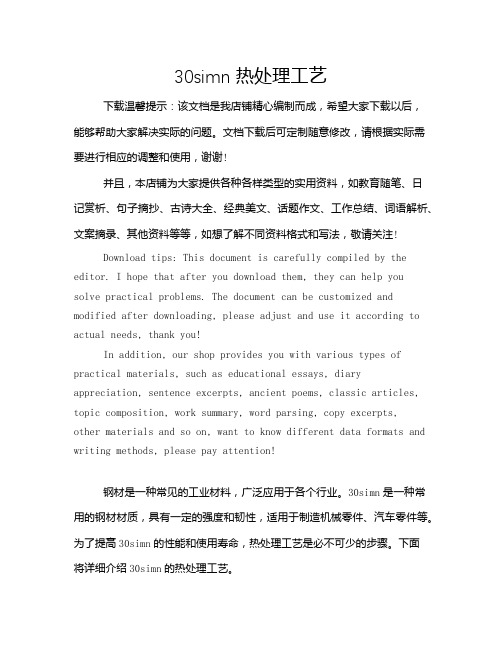
30simn热处理工艺下载温馨提示:该文档是我店铺精心编制而成,希望大家下载以后,能够帮助大家解决实际的问题。
文档下载后可定制随意修改,请根据实际需要进行相应的调整和使用,谢谢!并且,本店铺为大家提供各种各样类型的实用资料,如教育随笔、日记赏析、句子摘抄、古诗大全、经典美文、话题作文、工作总结、词语解析、文案摘录、其他资料等等,如想了解不同资料格式和写法,敬请关注!Download tips: This document is carefully compiled by the editor. I hope that after you download them, they can help yousolve practical problems. The document can be customized and modified after downloading, please adjust and use it according to actual needs, thank you!In addition, our shop provides you with various types of practical materials, such as educational essays, diary appreciation, sentence excerpts, ancient poems, classic articles, topic composition, work summary, word parsing, copy excerpts,other materials and so on, want to know different data formats and writing methods, please pay attention!钢材是一种常见的工业材料,广泛应用于各个行业。
热处理对30CrMnSiNi2A钢组织与动态性能的影响

热处理对30CrMnSiNi2A钢组织与动态性能的影响一、绪论1.1 研究背景和意义1.2 国内外研究现状和发展趋势1.3 研究内容和方法二、 30CrMnSiNi2A钢的组织和性能特点2.1 30CrMnSiNi2A钢的组成和晶体结构2.2 30CrMnSiNi2A钢的热处理工艺2.3 30CrMnSiNi2A钢的组织特征2.4 30CrMnSiNi2A钢的机械性能三、热处理对30CrMnSiNi2A钢组织的影响3.1 固溶处理对30CrMnSiNi2A钢的影响3.2 固溶处理过程中的相变行为3.3 淬火工艺对30CrMnSiNi2A钢的影响3.4 淬火处理过程中的相变行为四、热处理对30CrMnSiNi2A钢动态性能的影响4.1 热处理对30CrMnSiNi2A钢动态拉伸性能的影响4.2 热处理对30CrMnSiNi2A钢动态压缩性能的影响4.3 热处理对30CrMnSiNi2A钢动态应变率敏感性的影响五、结论5.1 热处理对30CrMnSiNi2A钢组织和性能的影响机理分析 5.2 热处理工艺优化建议5.3 未来研究展望第一章绪论1.1 研究背景和意义30CrMnSiNi2A钢是一种高强度、高韧性、高耐磨性的工程结构钢,在航空、航天、船舶、核电站、大型机械等领域有广泛的应用。
热处理是钢材加工中基础性和重要性的工艺之一,可以改善钢材组织和性能,提高其强度和韧性,进而改善整体性能,所以研究热处理对30CrMnSiNi2A钢的组织和性能的影响具有重要意义。
近年来,国内外针对30CrMnSiNi2A钢的热处理研究主要集中在固溶处理和淬火处理两个方面,但研究结果不尽相同,存在差异。
因此,继续探究不同热处理条件下的30CrMnSiNi2A钢组织和性能,研究各种热处理条件对其性能指标的影响程度,发掘热处理对30CrMnSiNi2A钢的微观组织与力学性能的影响规律并制定相应的热处理工艺,对于30CrMnSiNi2A钢的应用及其推广具有重要的科学价值和现实意义。
不同热处理工艺对Fe-30Mn-3Si-4AlTWIP钢力学组织性能的影响
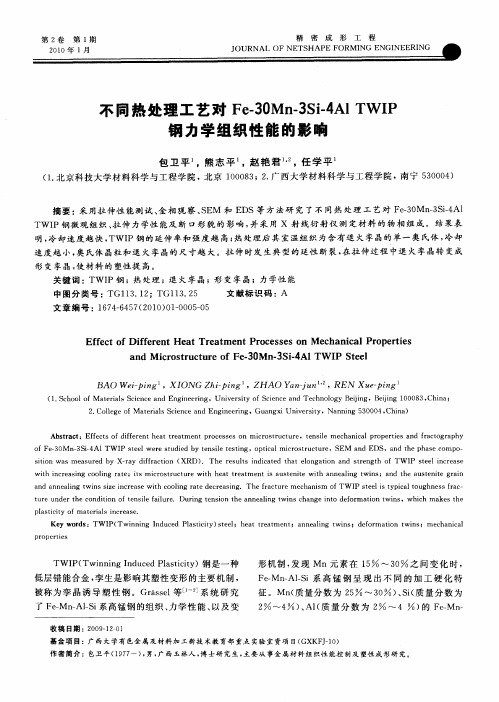
文 章 编 号 :1 7 - 4 7 2 1 ) 10 0 — 5 6 4 6 5 ( O 0 0 — 0 50
文献标 识码 : A
Ef e to if r n e tTr a m e o e s s o e h nia o e te f c fD fe e tH a e t ntPr c s e n M c a c lPr p r i s
2. le a e il in e a gi e i Co lgeofM t ra sSce c nd En ne rng, Gua gxiU nve st n i r iy,N a ni 0 4, n ng 53 00 Chi a) n
Ab ta t Efe t ifr n a r a m e oc s e ir tuc u e t nsl e ha ia r pe te nd fa t gr p sr c : f c sofd fe e the tte t ntpr e s son m c os r t r , e ie m c nc lp o ris a r c o a hy ofFe30M n 3S一 1TW l t e r t id b e i e tn 一 一 i4A P s e lwe es ude y t nsl t s ig,op ia ir tu t r e tc lm e osr c u e,SEM nd EDS,a heph e c po a nd t as om — sto s m e s r d by X—a fr c i (XRD ) The r s t i ia e ha eo a i nd te gt iin wa a u e r y difa ton . e uls ndc t d t t l ng ton a s r n h ofTW I s e li c e s P te n r a e w ih i r a ig c ln a e; is m ir tu t e w ih he r a m e s u t n t t ne i wi s;a h u t n t r i t nc e sn oo ig r t t c osr c ur t atte t nti a s e ie wih an al ng t n nd t e a s e ie g an a nn a ig t is sz nc e ew ih c ln a ede r a i g. Thef a t e m e h nim fTW I s e 1i yp c 1t ghn s r c nd a e ln w n ie i r as t oo ig r t c e sn r c ur c a s o P t e st ia ou e sfa —
30mnsi热处理工艺
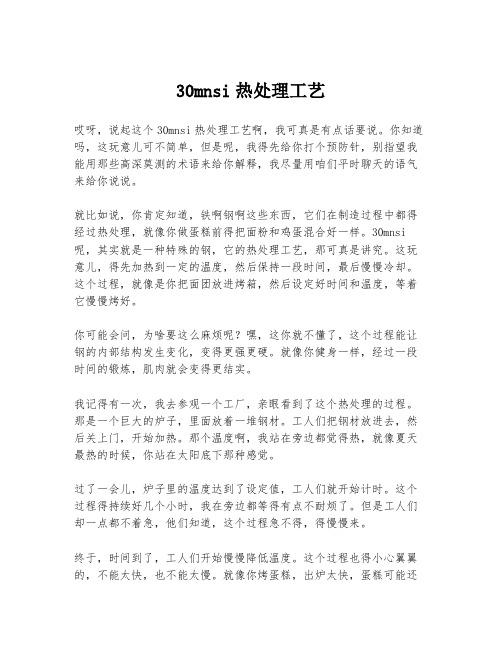
30mnsi热处理工艺哎呀,说起这个30mnsi热处理工艺啊,我可真是有点话要说。
你知道吗,这玩意儿可不简单,但是呢,我得先给你打个预防针,别指望我能用那些高深莫测的术语来给你解释,我尽量用咱们平时聊天的语气来给你说说。
就比如说,你肯定知道,铁啊钢啊这些东西,它们在制造过程中都得经过热处理,就像你做蛋糕前得把面粉和鸡蛋混合好一样。
30mnsi 呢,其实就是一种特殊的钢,它的热处理工艺,那可真是讲究。
这玩意儿,得先加热到一定的温度,然后保持一段时间,最后慢慢冷却。
这个过程,就像是你把面团放进烤箱,然后设定好时间和温度,等着它慢慢烤好。
你可能会问,为啥要这么麻烦呢?嘿,这你就不懂了,这个过程能让钢的内部结构发生变化,变得更强更硬。
就像你健身一样,经过一段时间的锻炼,肌肉就会变得更结实。
我记得有一次,我去参观一个工厂,亲眼看到了这个热处理的过程。
那是一个巨大的炉子,里面放着一堆钢材。
工人们把钢材放进去,然后关上门,开始加热。
那个温度啊,我站在旁边都觉得热,就像夏天最热的时候,你站在太阳底下那种感觉。
过了一会儿,炉子里的温度达到了设定值,工人们就开始计时。
这个过程得持续好几个小时,我在旁边都等得有点不耐烦了。
但是工人们却一点都不着急,他们知道,这个过程急不得,得慢慢来。
终于,时间到了,工人们开始慢慢降低温度。
这个过程也得小心翼翼的,不能太快,也不能太慢。
就像你烤蛋糕,出炉太快,蛋糕可能还没熟透;出炉太慢,蛋糕可能就糊了。
最后,钢材冷却到室温,热处理就完成了。
我看着那些经过热处理的钢材,它们看起来和放进去的时候没什么两样,但是我知道,它们的内部已经发生了翻天覆地的变化。
所以啊,别看这个30mnsi热处理工艺听起来挺高大上的,其实它就像是我们日常生活中的一些小事情,需要耐心,需要细心,最后才能得到好的结果。
就像我们做人一样,慢慢来,不着急,总会有收获的。
30crmnsia齿轮热处理

30crmnsia齿轮热处理
30CrMnSiA是一种常用的合金钢,常用于制造重载零部件、
高强度连杆和轴承等。
对于30CrMnSiA齿轮的热处理,一般
采用以下步骤:
1. 应先进行预热处理,将齿轮加热到适当的温度,通常选择温度为700℃-750℃,保持一段时间以均匀加热。
2. 预热后进行淬火处理,将齿轮迅速冷却,使其组织转变为马氏体组织。
淬火材料一般选择水、油等淬火介质,具体选择根据齿轮的尺寸和要求来决定。
3. 淬火后进行回火处理,将齿轮加热到一定温度范围,一般选择300℃-550℃之间的温度,保持一段时间,然后冷却到室温。
回火的目的是消除淬火产生的内部应力,并使齿轮获得合适的硬度和韧性。
4. 可选的处理方式还包括低温淬火和高温回火。
低温淬火可在-70℃至-90℃的低温下进行,可以提高齿轮的强度和韧性。
高
温回火可以在600℃-700℃的温度范围内进行,可以改善齿轮
的塑性和冲击韧性。
最后,进行热处理后的齿轮需要进行表面处理,如研磨、抛光等,以提高其表面光洁度和精度。
需要注意的是,热处理参数的选择应根据具体要求和设备进行调整,以确保齿轮的性能满足要求。
30号钢热处理
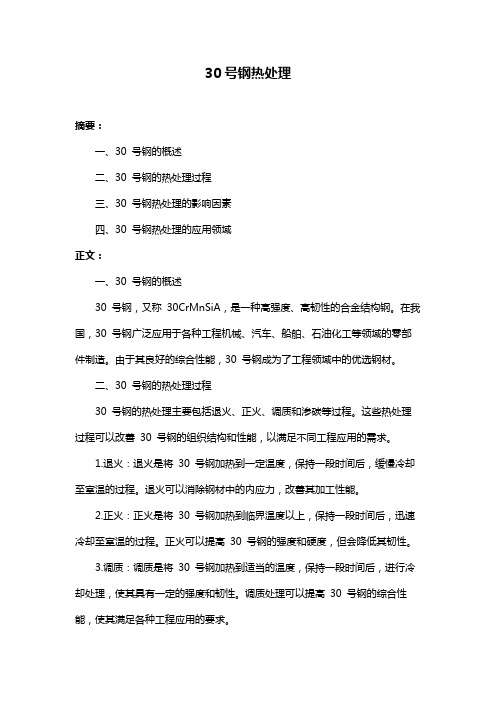
30号钢热处理摘要:一、30 号钢的概述二、30 号钢的热处理过程三、30 号钢热处理的影响因素四、30 号钢热处理的应用领域正文:一、30 号钢的概述30 号钢,又称30CrMnSiA,是一种高强度、高韧性的合金结构钢。
在我国,30 号钢广泛应用于各种工程机械、汽车、船舶、石油化工等领域的零部件制造。
由于其良好的综合性能,30 号钢成为了工程领域中的优选钢材。
二、30 号钢的热处理过程30 号钢的热处理主要包括退火、正火、调质和渗碳等过程。
这些热处理过程可以改善30 号钢的组织结构和性能,以满足不同工程应用的需求。
1.退火:退火是将30 号钢加热到一定温度,保持一段时间后,缓慢冷却至室温的过程。
退火可以消除钢材中的内应力,改善其加工性能。
2.正火:正火是将30 号钢加热到临界温度以上,保持一段时间后,迅速冷却至室温的过程。
正火可以提高30 号钢的强度和硬度,但会降低其韧性。
3.调质:调质是将30 号钢加热到适当的温度,保持一段时间后,进行冷却处理,使其具有一定的强度和韧性。
调质处理可以提高30 号钢的综合性能,使其满足各种工程应用的要求。
4.渗碳:渗碳是将30 号钢表面加热至高温,并在含碳介质中进行碳渗入的过程。
渗碳可以提高30 号钢表面的硬度和耐磨性,以满足某些特殊工程应用的需求。
三、30 号钢热处理的影响因素在进行30 号钢热处理过程中,影响热处理效果的因素主要包括:1.加热温度:加热温度的过高或过低都会影响30 号钢的组织结构和性能。
因此,在热处理过程中,需要严格控制加热温度。
2.保温时间:保温时间是指钢材在加热温度下保持的时间。
保温时间过长或过短都会影响30 号钢的热处理效果。
3.冷却介质:冷却介质的种类和冷却速度对30 号钢的热处理效果有较大影响。
不同的冷却介质和冷却速度会导致不同的组织结构和性能。
四、30 号钢热处理的应用领域经过热处理的30 号钢在各个工程领域中都有广泛的应用,如:1.工程机械:30 号钢经过热处理后,具有良好的强度、韧性和耐磨性,可用于制造工程机械的各类零部件。
30MnSi钢工艺优化探讨

30MnSi钢生产工艺优化的探讨刘钢王志明张旺胜(萍乡钢铁有限股份公司安源炼钢厂)摘要:本文针对萍钢安源炼钢厂30MnSi系列钢两种生产工艺进行分析,从而达到优化工艺和节约成本的目的,并对冶炼工艺及脱氧合金化工艺进行探讨。
关键字:30MnSi 工艺优化脱氧合金化Discussion on the practice process optimization of 30MnSiLiu Gang Wang Zhingming Zhang WangshengAbstract: this article from two practice process about 30MnSi to analysis is up to optimize this 30MnSi practice process and reducing the cost, meanwhile research the method of de-oxygen process about 30MnSi.Keywords: 30MnSi optimization process de-oxygen and alloying process一、前言30MnSi钢属于预应力钢棒又称预应力混凝土用钢棒、PC钢棒等,随着后现代工业的发展由城市发展转向城镇发展,高强度预应力钢棒用盘条的使用量逐年增加,各大中小型钢铁企业也加大了生产、开发研究的力度[1-6]。
同时在金融危机下,各钢厂都在大力进行工艺性优化、在保证质量的前提下,推进节约生产成本的力度,提高市场竞争力,本文针对萍钢安源炼钢厂30MnSi的工艺优化进行方向性的探讨。
二、生产条件2.1萍钢安源炼钢厂生产设备:一座铁水预处理站(单喷镁脱硫站)、年处理铁水能力60万吨,两座50t顶底复吹转炉,两台喂丝机(速度≥4m/s),钢包全程低吹系统,快速定氧仪器,大包长水口氩封系统以及中包保护浇注系统,170×170方坯连铸机,一座60tLF精练站。
浅析热处理工艺对稀土低合金钢组织和性能的影响
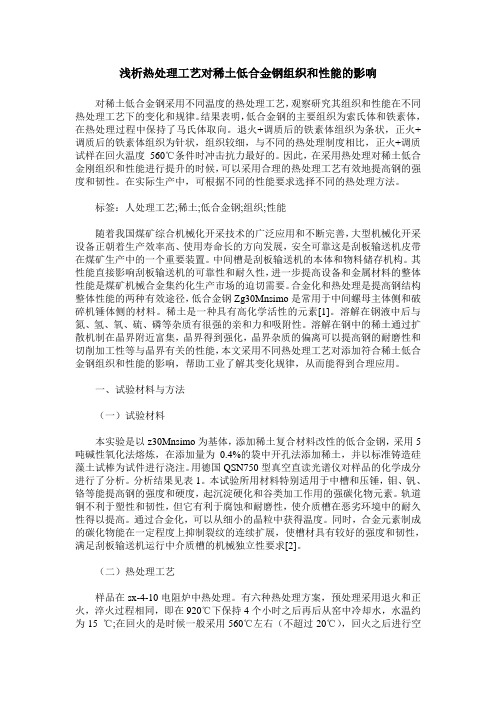
浅析热处理工艺对稀土低合金钢组织和性能的影响对稀土低合金钢采用不同温度的热处理工艺,观察研究其组织和性能在不同热处理工艺下的变化和规律。
结果表明,低合金钢的主要组织为索氏体和铁素体,在热处理过程中保持了马氏体取向。
退火+调质后的铁素体组织为条状,正火+调质后的铁素体组织为针状,组织较细,与不同的热处理制度相比,正火+调质试样在回火温度560℃条件时冲击抗力最好的。
因此,在采用热处理对稀土低合金刚组织和性能进行提升的时候,可以采用合理的热处理工艺有效地提高钢的强度和韧性。
在实际生产中,可根据不同的性能要求选择不同的热处理方法。
标签:人处理工艺;稀土;低合金钢;组织;性能随着我国煤矿综合机械化开采技术的广泛应用和不断完善,大型机械化开采设备正朝着生产效率高、使用寿命长的方向发展,安全可靠这是刮板输送机皮带在煤矿生产中的一个重要装置。
中间槽是刮板输送机的本体和物料储存机构。
其性能直接影响刮板输送机的可靠性和耐久性,进一步提高设备和金属材料的整体性能是煤矿机械合金集约化生产市场的迫切需要。
合金化和热处理是提高钢结构整体性能的两种有效途径,低合金钢Zg30Mnsimo是常用于中间螺母主体侧和破碎机锤体侧的材料。
稀土是一种具有高化学活性的元素[1]。
溶解在钢液中后与氮、氢、氧、硫、磷等杂质有很强的亲和力和吸附性。
溶解在钢中的稀土通过扩散机制在晶界附近富集,晶界得到强化,晶界杂质的偏离可以提高钢的耐磨性和切削加工性等与晶界有关的性能,本文采用不同热处理工艺对添加符合稀土低合金钢组织和性能的影响,帮助工业了解其变化规律,从而能得到合理应用。
一、试验材料与方法(一)试验材料本实验是以z30Mnsimo为基体,添加稀土复合材料改性的低合金钢,采用5吨碱性氧化法熔炼,在添加量为0.4%的袋中开孔法添加稀土,并以标准铸造硅藻土试棒为试件进行浇注。
用德国QSN750型真空直读光谱仪对样品的化学成分进行了分析。
分析结果见表1。
- 1、下载文档前请自行甄别文档内容的完整性,平台不提供额外的编辑、内容补充、找答案等附加服务。
- 2、"仅部分预览"的文档,不可在线预览部分如存在完整性等问题,可反馈申请退款(可完整预览的文档不适用该条件!)。
- 3、如文档侵犯您的权益,请联系客服反馈,我们会尽快为您处理(人工客服工作时间:9:00-18:30)。
f o r m a l s o o b v i o u s l y c h a n g e s .T h e v o l u me f r a c t i o n o f f e r r i t e i S a l s o a f f e c t e d b y t h e h o l d i n g t i me o f q u e n c h i n g .W i t h t h e q u e n c h i n g t e mp e r a t u r e i n c r e a s e f r o m 7 8 0 % t o 8 6 0 % a t h o l d i n g t i me a t 1 5 s ,t h e
第3 1卷 第 4期
2 0 1 3年 8月
贵州师 范大学学报 ( 自然科学版)
J o u r n a l o f G u i z h o u N o r m a l U n i v e r s i t y( N a t u r a l S c i e n c e s )
V0 1 . 3 1 . N o . 4
Au g 2 01 3
文章编号 : 1 0 0 4 -5 5 7 0 ( 2 0 1 3 ) 0 4~ 0 0 6 4— 0 4
Ef f e c t s o f h e a t t r e a t me n t p a r a me t e r s o n t h e 3 0 Mn S i S t e e l
T e c h n o l o g y a n d Ma t e r i a l s C o .L t d , C h i n a I r o n a n d S t e e l R e s e a r c h I n s t i t u t e G r o u p , B e r i n g 1 0 0 0 8 1 ,C h i n a )
组织结构受 到热处理 工艺参数 ( 快淬温度和时间) 的影 响。在 7 8 0 ℃至 8 6 0 %的温度范 围内 , 随着快淬 温度 的升
高, 合金 中的铁素体含量逐渐减少 , 且铁素体在合金基体 中的分布也有 明显变化 ; 此外 , 铁素体 的含量 也受快淬
时间的影响 , 当快淬时间为 1 5 s , 快淬温度达到 8 6 0 ℃ 时, 合金 钢中铁素体的含量 由 9 . 6 % 降低至 2 . 1 %。 关 键 词: 快淬 ; 时间; 微观组织结构
ZHANG F e i . p e n g ,Z ENG Ho n g
( 1 .I n s t i t u t e o f A p p l i e d S c i e n c e , He n a n U n i v e r s i t y o f U r b a n C o n s t r u c t i o n , P i n g d i n g s h a n , H e n a n 4 6 7 0 3 6 , C h i n a ; 2 . A d v a n c e d
Ab s t r a c t :Th e e f f e c t l a w o f he a t t r e a t me n t p a r a me t e r s,na me l y t h e q u e n c h i n g t e mp e r a t u r e a n d h o l i n g
v o l u me f r a c t i o n o f f e r r i t e d e c r e a s e s ro f m 9. 6% t o 2. 1% . Ke y wor ds:q u e n c h i n g;t i me;mi c r o s t r u c t u r e
t i me o n t h e mi c r o s t r u c t u r e o f 3 0 Mn S i s t e e l wa s s t u d i e d .T h e r e s u l t s s h o w t h a t w i t h i n t h e q u e n c h i n g
t e mp e r a t u r e r a ng e o f 78 0 —8 6 0 ̄ C ,t h e f e r r i t e c o n t e n t d e c r e a s e s g r a d u a l l y a n d t h e f e r r i t e d i s t r i bu t i o n
热 处理 工 艺对 3 0 M n S i 合 金钢 的影 响
张飞 鹏 ,曾 宏
( 1 . 河南城建 学院 数理 系, 河南 平顶 山 4 6 7 0 3 6 ; 2 .中国钢研科技集 团 安泰科技股份有限公司 , 北京 1 0 0 0 8 1 )
摘 要: 研究了热处理工艺参数对 3 0 Mn S i 合 金钢微 观组织结 构 的影 响。结果表 明, 3 0 M n S i 合 金钢 的成分 和微观
文献标识码 : A
s t r e n g t h h i g h e r t h a n 1 2 7 0 MP a ,e l o n g a t i o n p e r c e n t a g e
中 图分 类 号 : T G 1 1 5 . 5+ 7
